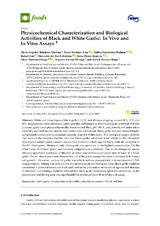Physicochemical Characterization and Biological Activities of Black and White Garlic: In Vivo and In Vitro Assays
Autor
Toledano Medina, María Ángeles
Merinas Amo, María Tania
Fernández Bedmar, Zahira Noemí
Font, Rafael
Río-Celestino, Mercedes del
Pérez-Aparicio, Jesús
Moreno Ortega, Alicia
Alonso Moraga, Ángeles
Moreno Rojas, Rafael
Editor
MDPIFecha
2019Materia
Black garlicPhysicochemical profile
Polyphenol content
HL-60 cell line
METS:
Mostrar el registro METSPREMIS:
Mostrar el registro PREMISMetadatos
Mostrar el registro completo del ítemResumen
White and three types of black garlic (13, 32, and 45 days of aging, named 0C1, 1C2, and 2C1, respectively) were selected to study possible differences in their nutraceutic potential. For this purpose, garlic were physicochemically characterized (Brix, pH, aW, L, polyphenol, and antioxidant capacity), and both in vivo and in vitro assays were carried out. Black garlic samples showed higher polyphenol content and antioxidant capacity than the white ones. The biological assays showed that none of the samples (neither raw nor black garlic) produced toxic effects in the Drosophila melanogaster animal genetic model, nor exerted protective effects against H2O2, with the exception of the 0C1 black garlic. Moreover, only white garlic was genotoxic at the highest concentration. On the other hand, 0C1 black garlic was the most antigenotoxic substance. The in vivo longevity assays showed significant extension of lifespan at some concentrations of white and 0C1and 1C2 black garlic. The in vitro experiments showed that all of the garlic samples induced a decrease in leukemia cell growth. However, no type of garlic was able to induce proapoptotic internucleosomal DNA fragmentation. Taking into account the physicochemical and biological data, black garlic could be considered a potential functional food and used in the preventive treatment of age-related diseases. In addition, our findings could be relevant for black-garlic-processing agrifood companies, as the economical and timing costs can significantly be shortened from 45 to 13 days of aging.

